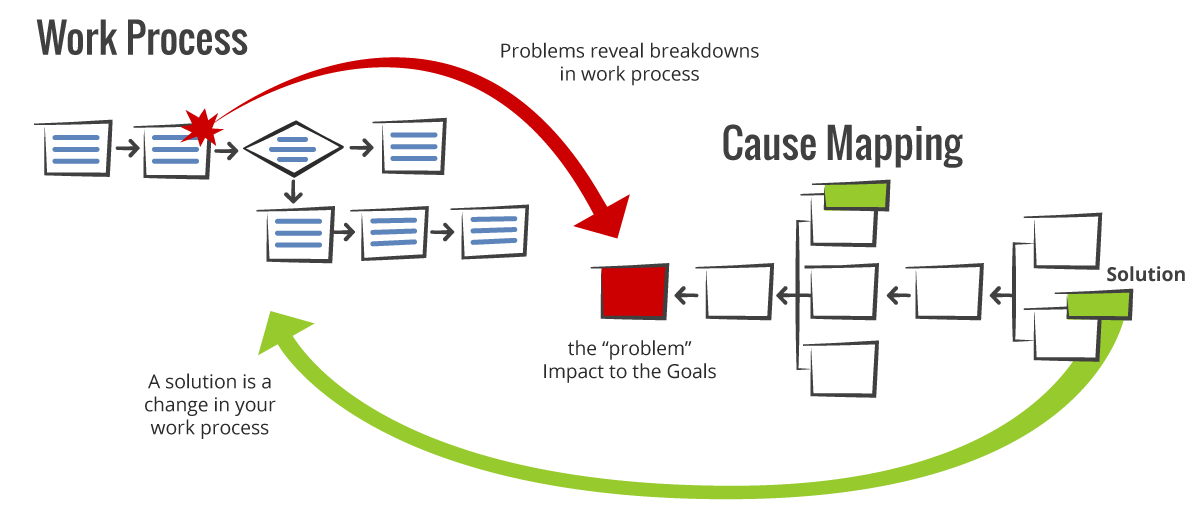Cause Mapping®
- - - - - - - - - - - - - -
 Problems pinpoint where work process needs to be improved
Problems pinpoint where work process needs to be improved
- - - - - - - - - -
Process dictates results. Your problems provide an opportunity for process clarity. In other words, problem-solving is an opportunity to identify the breakdowns and gaps within your work processes. By conducting a thorough investigation when a problem occurs, you have an opportunity to reveal lessons learned, which can then lead to the implementation of best practices across your organization.

These solutions represent continuous opportunities for improving processes at work. While this approach is reactive because we are looking at a problem that has already occurred, the solutions identified are proactive in that they allow us to make changes to the way we execute work processes going forward and mitigate the risk of other problems as well.
 A systems approach to mitigating risk
A systems approach to mitigating risk
- - - - - - - - - -
 The primary objective of an investigation is to prevent problems from reoccurring. Many people often mistakenly look for a singular root cause, thinking that they can eliminate the problem. Unfortunately, by looking for the “right” answer, we miss opportunities to mitigate risk. Prevention is all about mitigating risk. By taking a systems approach to root cause analysis, you expose multiple causes that work together to produce the problem. Revealing multiple causes provides multiple ways to prevent the problem. As Benjamin Franklin wisely stated,
The primary objective of an investigation is to prevent problems from reoccurring. Many people often mistakenly look for a singular root cause, thinking that they can eliminate the problem. Unfortunately, by looking for the “right” answer, we miss opportunities to mitigate risk. Prevention is all about mitigating risk. By taking a systems approach to root cause analysis, you expose multiple causes that work together to produce the problem. Revealing multiple causes provides multiple ways to prevent the problem. As Benjamin Franklin wisely stated,
“An ounce of prevention is worth a pound of cure.”
 Harness the power of visual communication
Harness the power of visual communication
- - - - - - - - - -
 There’s nothing more information dense than a map. Think of the amount of information that is captured and easily communicated on a single street map. Words and sentences alone cannot come close to this level of information density. Imagine being able to take advantage of the power of this visual communication when solving problems. A Cause Map™ diagram does exactly this. In addition to facilitating verbal discussions, a Cause Map diagram improves the process of collecting an organization’s information by showing how multiple perspectives all combined to produce the problem. Imagine an investigation without arguments and disagreements — this is one of the many advantages of using a Cause Map diagram to harness the power of visual communication.
There’s nothing more information dense than a map. Think of the amount of information that is captured and easily communicated on a single street map. Words and sentences alone cannot come close to this level of information density. Imagine being able to take advantage of the power of this visual communication when solving problems. A Cause Map™ diagram does exactly this. In addition to facilitating verbal discussions, a Cause Map diagram improves the process of collecting an organization’s information by showing how multiple perspectives all combined to produce the problem. Imagine an investigation without arguments and disagreements — this is one of the many advantages of using a Cause Map diagram to harness the power of visual communication.
 Keeping it simple
Keeping it simple
- - - - - - - - - -
Every problem can be broken down into basic cause-and-effect relationships. Many organizations consider cause-and-effect as too simple for complex issues. It appears simple because it’s fundamental. Cause-and-effect with supporting evidence is the basis of the scientific method. Cause Mapping® root cause analysis is a practical application of the cause-and-effect principle. It provides a consistent approach to investigating and preventing a wide array of problems across departments and disciplines.
 The most valuable problem-solving resource you already have
The most valuable problem-solving resource you already have
- - - - - - - - - -
 People solve problems. People design, install, operate, maintain, improve, and perform every task within an organization. People and processes are closely coupled to performance. Placing an emphasis on improving processes at work during an investigation allows an organization to demonstrate its commitment to its people. Unfortunately, many organizations inadvertently focus on the people or departments involved rather than on the specific causes of the problem. This creates an organizational culture that focuses more on blaming other groups and individuals than preventing problems from occurring. Do your investigations focus on … Prevention or blame?
People solve problems. People design, install, operate, maintain, improve, and perform every task within an organization. People and processes are closely coupled to performance. Placing an emphasis on improving processes at work during an investigation allows an organization to demonstrate its commitment to its people. Unfortunately, many organizations inadvertently focus on the people or departments involved rather than on the specific causes of the problem. This creates an organizational culture that focuses more on blaming other groups and individuals than preventing problems from occurring. Do your investigations focus on … Prevention or blame?
 Getting started with the Cause Mapping® Method
Getting started with the Cause Mapping® Method
- - - - - - - - - -
We make it easy to get started. Our website contains many helpful resources for learning about Cause Mapping root cause analysis and improving processes at work.
Root cause analysis
- - - - - - - - - -
Learn more about root cause analysis.
Cause Mapping®
- - - - - - - - - -
See how Cause Mapping root cause analysis works.
Free Webinars
- - - - - - - - - -
View our free online presentations.
Free Template
- - - - - - - - - -
Download our free Cause Mapping template.






